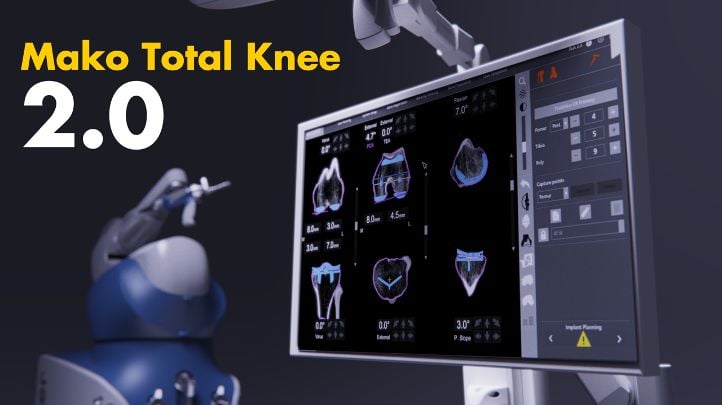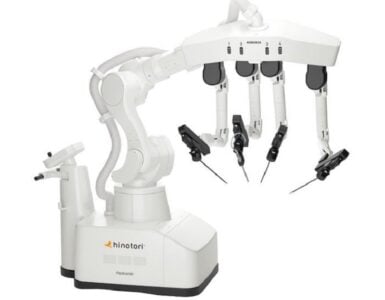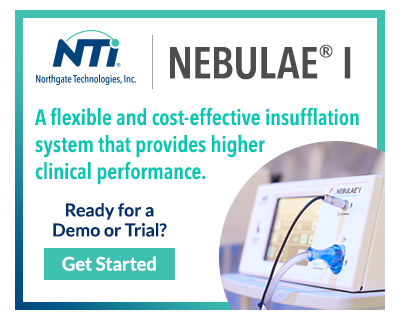Stryker announces the launch of Mako Total Knee 2.0, the next chapter in Mako SmartRobotics™, at the AAOS 2023 Annual Meeting in Las Vegas. Informed by over 500,000 Mako Total Knee procedures, Mako Total Knee 2.0 is designed to deliver the same, trusted outcomes surgeons expect from Mako with a new, elevated user experience.
Mako Total Knee 2.0 introduces a new intuitive design, customizable workflow and other key features, including an innovative digital tensioner that allows surgeons to assess the stability of the knee intraoperatively during a total knee arthroplasty (TKA) without the need for additional instrumentation. Mako Total Knee 2.0 is built on the legacy of Mako SmartRobotics™ and its three key components – 3D CT-based planning, AccuStop™ haptic technology and Insightful Data Analytics, which have shown better outcomes for total knee, total hip and partial knee patients, compared to manual surgery.1,2,3
“Mako Total Knee 2.0 combines our cutting edge Mako Technology with our clinically proven Triathlon implants to help surgeons deliver enhanced patient outcomes,” said Don Payerle, president of Stryker’s Joint Replacement division. “Over the last six years, we’ve gathered key feedback from our customers and incorporated those findings into the development of Mako Total Knee 2.0 – reflecting our ongoing commitment to our customers and their patients.”
Today, there are Mako Systems installed across 35 countries, and more than 1 million Mako procedures have been performed worldwide.
“Stryker’s recent 1 million procedure milestone is an unprecedented achievement in orthopaedic robotics and a testament to the overwhelming global adoption and patient impact of Mako SmartRobotics,” said Payerle. “We look forward to continuing to help so many patients get back to the activities they love.”
With over 3,000 cases to date, Mako Total Knee 2.0 began limited release in August 2022, and will continue to roll out in a phased approach in 2023, beginning in the United States and following with global launch activities in select markets.
AAOS 2023 attendees can visit Stryker’s booth (#4243) to learn more about Mako Total Knee 2.0. Stryker will hold live demonstrations, exhibitions and a symposium throughout the 2023 Annual Meeting.
Those living with joint pain are encouraged to speak with their healthcare professional about available treatment plans. As a provider, surgeons can help patients get educated on options that may help prevent further pain and complications.
All surgery carries risk. Surgeons must rely on their own professional clinical judgment when deciding whether to utilize a particular technology when treating a patient in their own practice. Stryker does not dispense medical advice and recommends that surgeons be trained in the use of any technology before using it in surgery. Not all patients will have the same postoperative recovery and activity level. Individual results vary.
1. Illgen, R, Bukowski, B, Abiola, R, Anderson, P, Chughtai, M, Khlopas, A, Mont, M. Robotic assisted total hip arthroplasty: Outcomes at minimum two year follow up. Surgical Technology International. 2017 July 25; 30:365-372.
2. Kayani B, Konan S, Tahmassebi J, Pietrzak JRT, Haddad FS. Robotic-arm assisted total knee arthroplasty is associated with improved early functional recovery and reduced time to hospital discharge compared with conventional jig-based total knee arthroplasty: a prospective cohort study. The Bone and Joint Journal. 2018;100-B:930-7.
3. Burger JA, Kleeblad LJ, Laas N, Pearle AD. Mid-term survivorship and patient-reported outcomes of robotic-arm assisted partial knee arthroplasty. Bone Joint J. 2020;102-B(1):108-116.
Source: Stryker











